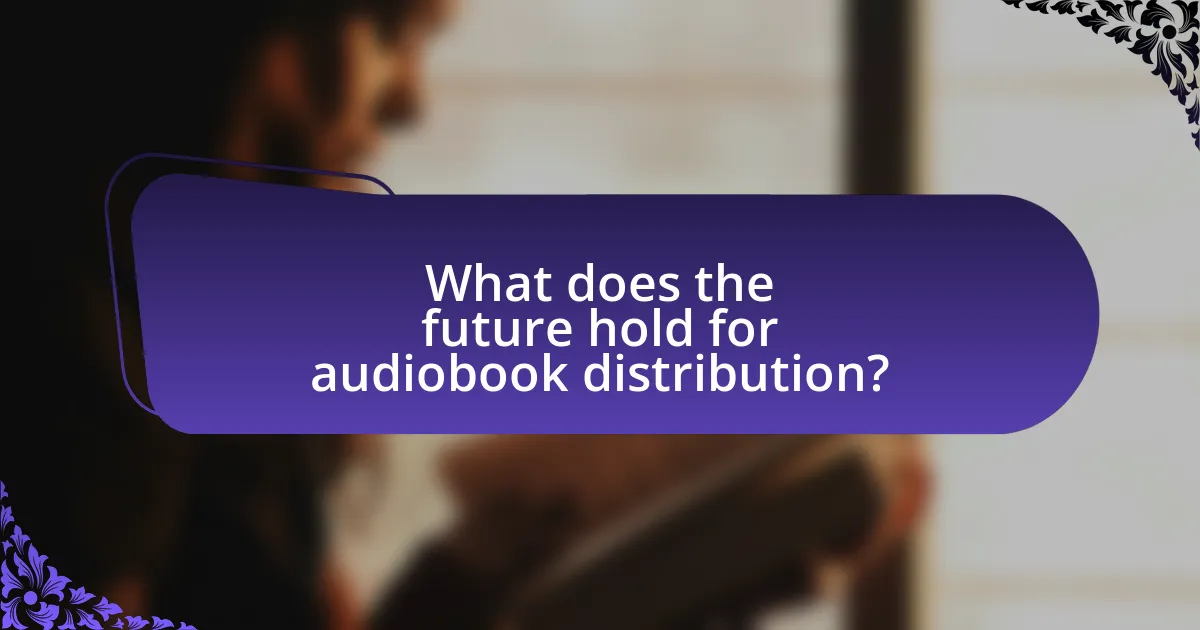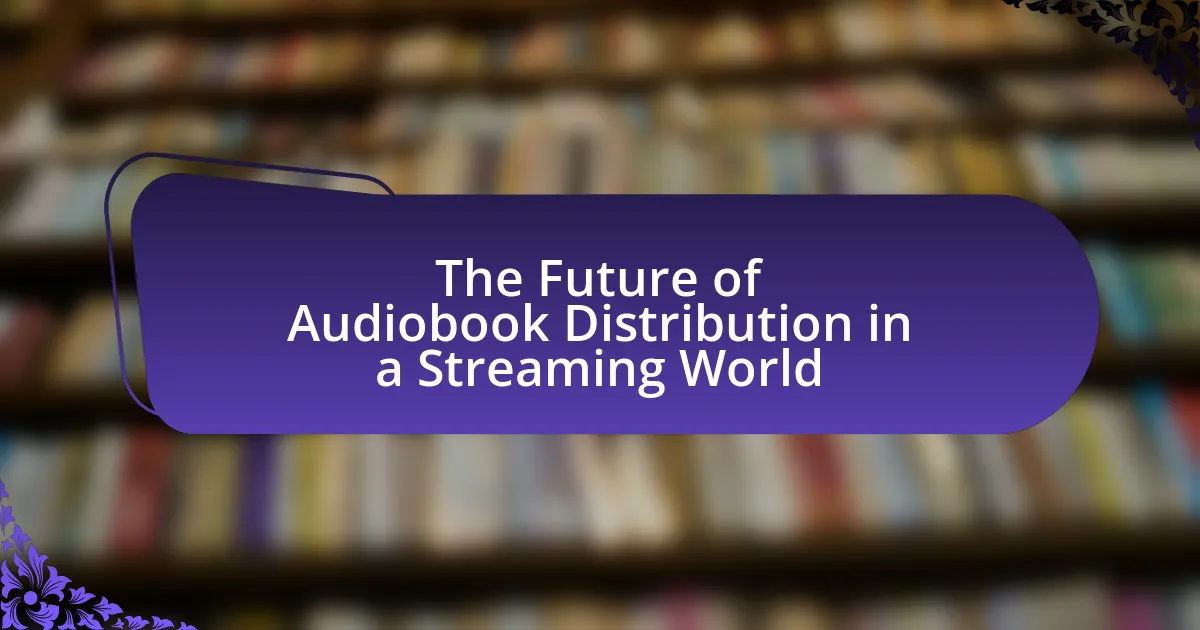The article examines the future of audiobook distribution in a streaming-centric environment, highlighting the shift towards subscription-based models and increased accessibility through platforms like Audible and Spotify. It discusses the changing landscape of audiobook distribution, driven by technological advancements and evolving consumer preferences, which favor convenience and personalized content. Key challenges such as revenue models, copyright issues, and market saturation are addressed, alongside effective marketing strategies that leverage social media and data analytics. The article concludes by exploring the potential impact of emerging technologies, including artificial intelligence and virtual reality, on the audiobook experience and distribution practices.

What is the Future of Audiobook Distribution in a Streaming World?
The future of audiobook distribution in a streaming world is characterized by increased accessibility and subscription-based models. As streaming services like Audible and Spotify expand their offerings, consumers will have greater access to a diverse range of audiobooks without the need for individual purchases. This shift is supported by the growing trend of digital consumption, with the audiobook market projected to reach $35 billion by 2028, according to a report by Grand View Research. Additionally, the integration of audiobooks into existing streaming platforms will likely lead to a more seamless user experience, encouraging higher engagement and consumption rates.
How is the audiobook distribution landscape changing?
The audiobook distribution landscape is changing due to the rise of streaming services and direct-to-consumer models. Streaming platforms like Audible and Spotify are increasingly dominating the market, offering subscription-based access to vast libraries of audiobooks, which contrasts with traditional purchase models. According to a report by the Audio Publishers Association, the audiobook market grew by 25% in 2020, indicating a shift towards digital consumption and subscription services. This evolution is further supported by the increasing popularity of mobile devices, which facilitate easy access to audiobooks anytime and anywhere, thus reshaping consumer habits and preferences in audiobook consumption.
What technological advancements are influencing audiobook distribution?
Technological advancements such as streaming platforms, artificial intelligence, and enhanced mobile applications are significantly influencing audiobook distribution. Streaming platforms like Audible and Spotify have revolutionized access by allowing users to listen to a vast library of audiobooks on-demand, which has increased consumer engagement and sales. Artificial intelligence is being utilized for personalized recommendations, improving user experience by suggesting titles based on listening habits. Additionally, mobile applications have enhanced accessibility, enabling users to download and listen to audiobooks anywhere, thus expanding the market reach. These advancements collectively contribute to a more dynamic and user-friendly audiobook distribution landscape.
How do consumer preferences impact audiobook distribution models?
Consumer preferences significantly influence audiobook distribution models by driving the demand for subscription services and personalized content. As listeners increasingly favor convenience and accessibility, platforms like Audible and Spotify have adapted their models to offer subscription-based access, allowing users to consume a wide range of audiobooks for a fixed monthly fee. According to a 2021 report by the Audio Publishers Association, 75% of audiobook listeners prefer subscription services, indicating a clear shift towards this model. Additionally, consumer preferences for curated and personalized recommendations have led to algorithms that suggest titles based on listening history, further shaping distribution strategies. This alignment with consumer desires for flexibility and tailored experiences is essential for audiobook platforms to remain competitive in a rapidly evolving market.
Why is streaming becoming the dominant model for audiobook distribution?
Streaming is becoming the dominant model for audiobook distribution due to its convenience and accessibility for consumers. This model allows users to listen to a vast library of audiobooks on-demand without the need for physical ownership or downloads, which aligns with the growing preference for subscription-based services. According to a report by the Audio Publishers Association, the audiobook market has seen significant growth, with revenue increasing by 25% in 2020, largely driven by the popularity of streaming platforms like Audible and Spotify. These platforms offer users the ability to explore diverse genres and titles, enhancing user engagement and satisfaction.
What advantages does streaming offer over traditional audiobook sales?
Streaming offers greater accessibility and flexibility compared to traditional audiobook sales. Users can access a vast library of audiobooks on-demand without the need for individual purchases, allowing for exploration of different genres and titles without financial commitment. Additionally, streaming services often provide features such as offline listening, personalized recommendations, and the ability to switch between devices seamlessly. These advantages cater to consumer preferences for convenience and variety, which are increasingly important in the digital age.
How are major players in the industry adapting to streaming trends?
Major players in the audiobook industry are adapting to streaming trends by developing subscription-based models and enhancing user engagement through personalized recommendations. Companies like Audible and Scribd have introduced monthly subscription plans that allow users unlimited access to a vast library of audiobooks, reflecting the successful strategies of music streaming services. Additionally, these platforms utilize algorithms to analyze user preferences and listening habits, thereby offering tailored content that increases user retention and satisfaction. This shift towards a streaming-centric approach is supported by the growing consumer demand for on-demand audio content, as evidenced by a 2022 report from the Interactive Advertising Bureau, which indicated a 25% increase in audiobook consumption over the previous year.
What challenges does the audiobook industry face in a streaming environment?
The audiobook industry faces significant challenges in a streaming environment, primarily due to issues related to revenue models and content ownership. Streaming platforms often operate on subscription-based models, which can lead to reduced per-audiobook revenue for publishers and authors compared to traditional sales. For instance, a report from the Audio Publishers Association indicates that while audiobook sales grew to $1.3 billion in 2020, the shift to streaming could dilute earnings as consumers may prioritize access over ownership. Additionally, the competition from various streaming services complicates market positioning, making it difficult for individual titles to stand out. This environment also raises concerns about intellectual property rights, as the terms of service on streaming platforms can limit the control authors and publishers have over their content.
How does copyright and licensing affect audiobook distribution?
Copyright and licensing significantly influence audiobook distribution by determining the legal rights and permissions required for the reproduction and distribution of audio content. Audiobook publishers must secure licenses from copyright holders, typically authors or their estates, to legally produce and distribute audiobooks. This process ensures that creators are compensated for their work, as copyright law protects their intellectual property rights. For instance, the U.S. Copyright Act grants authors exclusive rights to their works, including the right to reproduce and distribute them, which directly impacts how audiobooks are made available to consumers. Without proper licensing, distributors risk legal repercussions, including fines and the potential for lawsuits, which can hinder their ability to operate in the market.
What are the implications of market saturation for audiobook distributors?
Market saturation for audiobook distributors leads to increased competition, resulting in reduced profit margins and a need for differentiation. As more players enter the market, distributors face challenges in attracting and retaining customers, which can lead to price wars and diminished revenue. According to a report by the Audio Publishers Association, the audiobook market has seen significant growth, but with over 50% of U.S. adults now familiar with audiobooks, the potential for new customer acquisition diminishes. This saturation compels distributors to innovate in content offerings and marketing strategies to maintain market share and profitability.

How are audiobooks being marketed in a streaming world?
Audiobooks are being marketed in a streaming world through subscription services, targeted advertising, and partnerships with popular platforms. Subscription services like Audible and Scribd offer users access to vast libraries of audiobooks for a monthly fee, making it convenient for consumers to explore new titles. Targeted advertising leverages data analytics to reach potential listeners based on their preferences and listening habits, enhancing engagement. Additionally, partnerships with platforms such as Spotify and Apple Music allow audiobooks to reach broader audiences, integrating them into existing streaming habits. This multi-faceted approach reflects the growing trend of audiobooks adapting to consumer preferences in a digital streaming landscape.
What strategies are effective for promoting audiobooks in a streaming context?
Effective strategies for promoting audiobooks in a streaming context include leveraging social media marketing, utilizing influencer partnerships, and offering exclusive content. Social media platforms like Instagram and TikTok allow for targeted advertising and engagement with potential listeners, as evidenced by the rise of audiobooks promoted through viral trends. Influencer partnerships can amplify reach, as influencers often have dedicated followings that trust their recommendations, leading to increased audiobook sales. Additionally, offering exclusive content, such as author interviews or behind-the-scenes insights, can entice users to subscribe to streaming services, as seen in successful campaigns by platforms like Audible. These strategies collectively enhance visibility and listener engagement in the competitive audiobook market.
How do social media and influencer marketing play a role in audiobook promotion?
Social media and influencer marketing significantly enhance audiobook promotion by leveraging vast online audiences and targeted engagement strategies. Platforms like Instagram, TikTok, and Twitter allow authors and publishers to reach potential listeners through visually appealing content and authentic endorsements. For instance, TikTok’s #BookTok trend has led to a surge in audiobook sales, with reports indicating that audiobooks featured in popular videos can see sales increases of over 300%. Influencers, who often have dedicated followings, can create buzz around new releases, share personal reviews, and provide exclusive content, making audiobooks more accessible and appealing to diverse demographics. This synergy between social media and influencer marketing effectively drives awareness and sales in the competitive audiobook market.
What role do user reviews and ratings have in audiobook marketing?
User reviews and ratings play a crucial role in audiobook marketing by influencing potential listeners’ purchasing decisions. Research indicates that 70% of consumers trust online reviews as much as personal recommendations, highlighting the impact of user-generated content on consumer behavior. Positive reviews can enhance an audiobook’s visibility and credibility, leading to increased sales and listener engagement. Conversely, negative ratings can deter potential buyers, making it essential for audiobook marketers to actively manage and encourage favorable reviews to optimize their marketing strategies.
How can authors and publishers leverage streaming platforms for success?
Authors and publishers can leverage streaming platforms for success by utilizing these platforms to reach wider audiences and enhance engagement with their content. Streaming platforms, such as Audible and Spotify, provide access to millions of potential listeners, allowing authors to distribute audiobooks efficiently. For instance, the global audiobook market was valued at approximately $3.5 billion in 2020 and is projected to grow significantly, indicating a rising demand for audio content. By partnering with these platforms, authors can benefit from promotional tools and algorithms that recommend their works to targeted listeners, increasing visibility and sales. Additionally, streaming platforms often offer subscription models that can lead to higher consumption rates, allowing authors to earn royalties based on listenership rather than outright sales. This model encourages continuous engagement with the audience, fostering a loyal listener base.
What partnerships can authors form with streaming services to enhance visibility?
Authors can form partnerships with streaming services by collaborating on exclusive audiobook releases or promotional events. These partnerships can enhance visibility by leveraging the streaming service’s established audience and marketing capabilities. For instance, authors can negotiate exclusive rights for their audiobooks on platforms like Audible or Spotify, which can lead to increased exposure through featured placements and curated playlists. Additionally, authors can participate in live readings or interviews hosted by the streaming service, further engaging listeners and driving interest in their works. Such collaborations have been shown to significantly boost sales and listener engagement, as evidenced by the success of exclusive content on platforms like Audible, which reported a 30% increase in listener retention for exclusive titles.
How can data analytics from streaming platforms inform marketing strategies?
Data analytics from streaming platforms can significantly inform marketing strategies by providing insights into user behavior, preferences, and engagement patterns. For instance, streaming platforms collect data on listening habits, such as which audiobooks are most popular, the average listening duration, and user demographics. This data enables marketers to tailor their campaigns to target specific audiences effectively.
Moreover, analytics can reveal trends in content consumption, allowing marketers to identify emerging genres or themes that resonate with listeners. According to a report by Nielsen, 60% of audiobook listeners prefer specific genres, which can guide marketing efforts to focus on those areas. Additionally, real-time analytics can help marketers adjust their strategies dynamically based on immediate feedback from users, optimizing promotional efforts and enhancing user engagement.

What does the future hold for audiobook distribution?
The future of audiobook distribution is expected to be dominated by streaming services and subscription models. As consumer preferences shift towards on-demand content, platforms like Audible, Spotify, and Apple Books are likely to expand their offerings, making audiobooks more accessible. According to a report by the Audio Publishers Association, the audiobook market has seen consistent growth, with sales increasing by 12% in 2020 alone, indicating a strong trend towards digital consumption. This growth suggests that audiobook distribution will increasingly rely on technology-driven platforms that facilitate easy access and personalized recommendations for users.
How might emerging technologies shape the future of audiobook distribution?
Emerging technologies will significantly shape the future of audiobook distribution by enhancing accessibility, personalization, and interactivity. For instance, advancements in artificial intelligence and machine learning can enable more tailored recommendations based on user preferences, improving user engagement. Additionally, the rise of blockchain technology could facilitate secure and transparent transactions, allowing authors and publishers to receive fair compensation directly from consumers. According to a report by the Audio Publishers Association, the audiobook market has been growing steadily, with sales increasing by 12% in 2020, indicating a strong demand for innovative distribution methods. These technologies will likely streamline the distribution process, making audiobooks more readily available across various platforms and devices.
What role will artificial intelligence play in audiobook creation and distribution?
Artificial intelligence will significantly enhance audiobook creation and distribution by automating narration, improving personalization, and optimizing marketing strategies. AI technologies, such as text-to-speech systems, can produce high-quality audio narrations that mimic human voices, reducing the need for professional voice actors and lowering production costs. Additionally, AI algorithms can analyze listener preferences and behaviors, enabling publishers to tailor recommendations and marketing efforts, thus increasing engagement and sales. According to a report by Grand View Research, the global audiobook market is expected to reach $35 billion by 2030, partly driven by advancements in AI that streamline production and enhance user experience.
How could virtual reality and augmented reality impact the audiobook experience?
Virtual reality (VR) and augmented reality (AR) could significantly enhance the audiobook experience by creating immersive storytelling environments. VR can transport listeners into a fully realized 3D world that corresponds with the narrative, allowing them to visualize scenes and characters, which can deepen emotional engagement. For instance, a study by the University of Southern California found that immersive experiences can increase empathy and retention of information, suggesting that VR could make audiobooks more impactful.
AR can overlay digital elements onto the real world, enabling listeners to interact with the story in a more dynamic way. For example, while listening to an audiobook, users could see visual representations of characters or settings in their physical space, enhancing comprehension and enjoyment. Research from the Journal of Augmented and Virtual Reality indicates that AR can improve user engagement and learning outcomes, supporting the idea that integrating AR into audiobooks could lead to a richer experience.
Overall, both VR and AR have the potential to transform audiobooks from passive listening experiences into interactive, engaging narratives that foster deeper connections with the content.
What best practices should authors and publishers follow in a streaming world?
Authors and publishers should prioritize accessibility, quality, and engagement in a streaming world. Ensuring that audiobooks are available on multiple streaming platforms increases reach and audience engagement, as evidenced by the growth of platforms like Audible and Spotify, which have reported significant increases in user subscriptions and listening hours. Additionally, maintaining high audio quality is crucial; studies show that listeners are more likely to continue with a title that has clear narration and professional production. Finally, fostering community engagement through social media and interactive content can enhance listener loyalty, as seen in successful campaigns by authors who actively connect with their audience.
How can authors optimize their content for streaming platforms?
Authors can optimize their content for streaming platforms by focusing on high-quality audio production, engaging storytelling, and strategic marketing. High-quality audio production ensures clarity and enhances listener experience, which is crucial as studies show that 70% of listeners prefer well-produced audiobooks. Engaging storytelling captivates audiences, leading to higher retention rates; research indicates that compelling narratives can increase listener engagement by up to 50%. Strategic marketing, including leveraging social media and partnerships with influencers, can significantly boost visibility and reach, as 80% of audiobook sales are influenced by online recommendations. By implementing these strategies, authors can effectively enhance their content’s performance on streaming platforms.
What are the key considerations for pricing audiobooks in a streaming model?
Key considerations for pricing audiobooks in a streaming model include production costs, market demand, competitive pricing, and consumer behavior. Production costs encompass expenses related to recording, editing, and distributing audiobooks, which directly influence pricing strategies. Market demand is assessed through consumer interest and trends, indicating how much customers are willing to pay for access to audiobooks. Competitive pricing involves analyzing similar offerings from other streaming services to ensure attractiveness and viability in the market. Lastly, understanding consumer behavior, such as preferences for subscription models versus pay-per-title, helps tailor pricing to maximize user engagement and revenue. These factors collectively inform effective pricing strategies in the evolving landscape of audiobook distribution.



